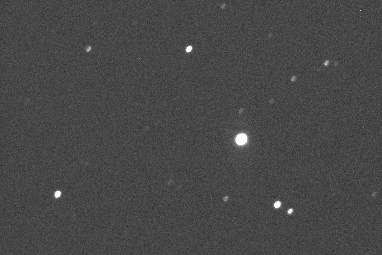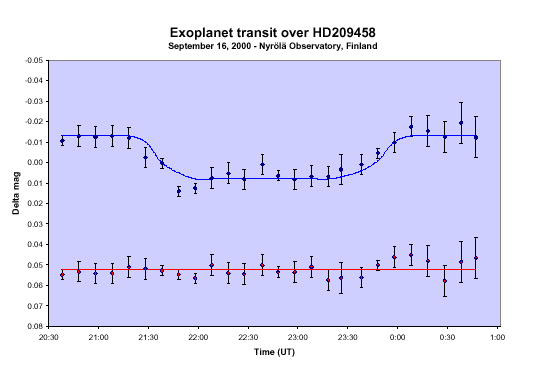HD209458 Exoplanet transit
The
first amateur observation of exoplanet transit from Nyrölä Observatory
September 16, 2000
The winner
of
SBIG contest of January 2002!

|
Drawing
of planet transiting HD209458.
Copyright: Lynette Cook. Used with permission.
|
As the night darkened at Nyrölä
observatory on September 16, 2000 group of amateur astronomers of
Jyväskylän Sirius prepared to observe a planet orbiting a star 153
light years away. The star was HD209458 in Pegeasus and its still unnamed
jupiter-like planet was about to transit over the star face. The planet orbits
very close of the star and transits every 3.5 days dimming the star just a bit.
Before these transits had been observed by a few professional observatories.
Observers included some of the most active
members of Sirius: Marko Moilanen, Jalo Ojanperä, Jouni Sorvari, Aki Id and
Arto Oksanen. We started the observing run at 20.33 UT when there was about one
hour to the beginning of transit by prdiction published on exoplaners.org web
page. Even though the star is too dim to see on naked eye it was very bright
object for CCD-imager and limited the exposure time to just 10 seconds. We
logged about four images per minute and continued observing for next four and
half hours to record full transit.

|
The
first one of the 866 raw images recorded on September 16, 2000.
HD209458 is the brightest star on the image.
|
From the individual images the
dimming caused by the planet was not measurable. The measurement errors vere far
larger than the magnitude drop. All 866 images were carefully calibrated and
each star was measured with IRAF software. Still the transit was not visible
even though the preliminary lightcurve showed some indications of it. Only after
all measurements of each 10 minute timeslot were averaged to reduce errors the
transit became very obvious on the lightcurve. The transit times agreed very
well with the predictions and observed magnitude drop on V-band was 0.02
magnitudes. Still the errors are quite large, but less than the magnitude drop.
One of the field stars was used to check the measurements and its magnitude
remained constant (within errors) during the transit. We had succeeded in what
we thought to be impossible, we had detected a exoplanet transit!

|
Final
lightcurve of the September 16, 2000 transit. HD209458 is on the top
and ja bellow is one of the check stars offsetted by 0.05 magnitudes.
|
Professor Geoffrey Marcy from University of
California at Berkeley confirmed our observation and told that we were the first
amateur group succeeded observing exoplanet transit. In the future we will try
to find new transiting exoplanets using the predictions Marcy's research group
has computed from spectroscopic observations.
The equipments used on the observation were a
16-inch Meade LX200 telescope and SBIG ST7E CCD-imager with photometric
V-filter. Meade f6.3 focal reducer and JMI's NGF-S digital focuser were used as
well. The CCD was controlled with MaxIm DL 2.0
software.
Further reading:



